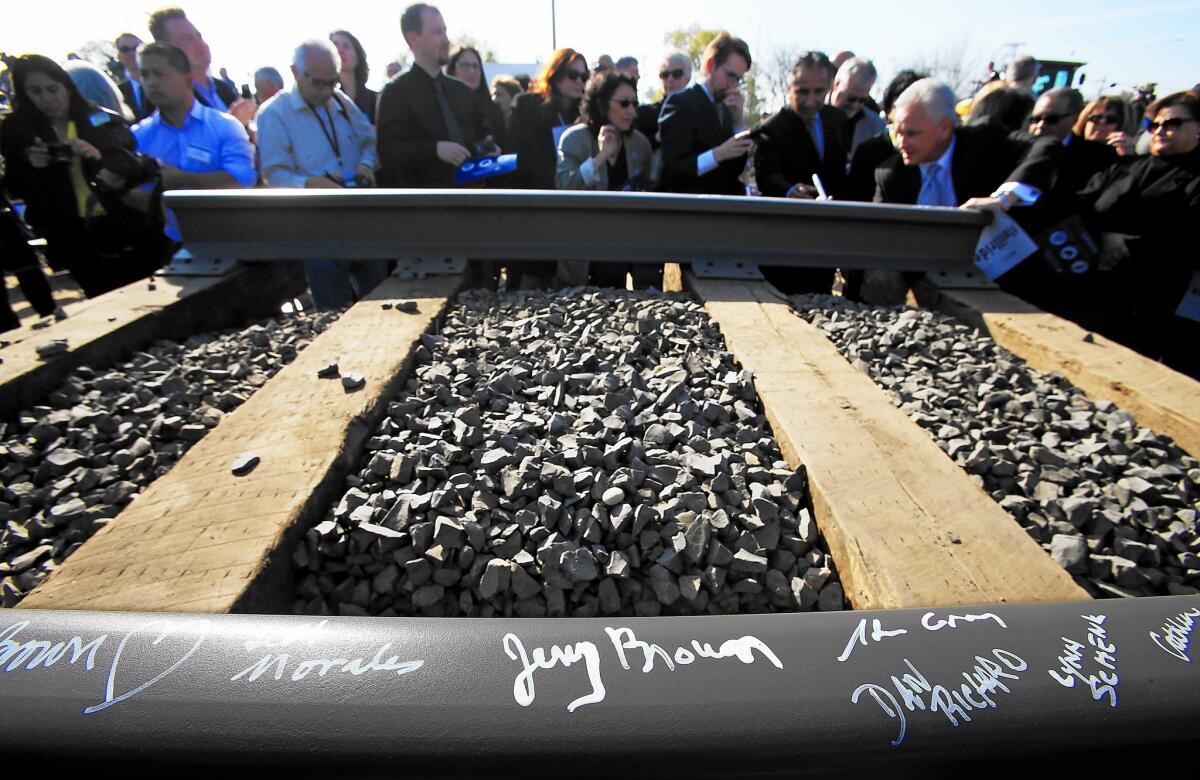California Journal: A bullet train from L.A. to San Francisco? Have a little faith

- Share via
reporting from FRESNO — Tuesday’s groundbreaking for California’s bullet train was sort of like having a christening with the baby still in utero.
Strike that.
It was like having a christening for a baby that’s still an embryo in a Petri dish.
As exciting as it is to think about whizzing between Los Angeles and San Francisco in two or three hours, we are still many years away from riding on a high-speed train.
How many years?
Let me put it this way: If you were in kindergarten right now, you would be able to expect to take your first ride on a bullet train about the time you were declaring your college major.
“I will make sure we do everything we can to get there quicker than that,” said an ebullient Gov. Jerry Brown, 76, who popped down to Fresno for the groundbreaking the day after he was sworn in for his historic fourth term. “I’ll be 92 in 2030. So I’m working out and pumping iron and eating vegetables.”
Brown swatted aside the most potent criticism of the $68-billion project — that no one really knows where most of the money is going to come from. “When I first was elected governor, I had some doubts about this project,” Brown said. “I wasn’t quite sure where the hell we were going to get the rest of the money. But don’t worry about it. We’re going to get it.”
Commitments from the state and federal government could provide as much as $26 billion over the next decade and a half, but the source for the rest of the funds is unclear. As my colleague Ralph Vartabedian has reported, the California High-Speed Rail Authority expects to sell ad space on the trains, and anticipates that private companies will invest in the system once the first segment, a 29-mile stretch between Madera and Fresno, is up and running in about seven years.
“It’s not that expensive,” said the notoriously frugal Brown. “We can afford it.”
There are no guarantees, though, and congressional Republicans have been withering about future federal help. (“They can make these threats,” said train spokeswoman Lisa Marie Alley, when a reporter challenged her about the funding, “but we don’t need any more money from Congress, and we’re not expecting anything.”)
In the great scheme of things, though, Brown is right. It’s not that much money. Funds have a way of materializing for monumentally expensive American ventures — even the misbegotten ones. Did we have a few trillion dollars lying around to prosecute the war in Iraq? Did that stop us?
In spite of myself and the bullet train’s many, many skeptics, I believe the governor. Why not?
This is a man who returned to power in 2011 as the state’s demise was being predicted far and wide. California, with a $26-billion deficit, was becoming another Greece. California, with its dysfunctional Legislature and weirdly polarized inland vs. coastal population, was ungovernable. Businesses and residents were said (most persistently by Texas Gov. Rick Perry and other Republicans) to be fleeing the state, searching for lower taxes and cheaper real estate.
That was hooey. Businesses want to be here because California is a cradle of innovation, with great research universities providing a highly skilled workforce. Homes are expensive here because our quality of life is better than just about anywhere else.
Now Brown is running a state with a balanced budget, a rainy day fund and an unemployment rate that has plunged from 12% to 7%. Did Brown do it all by himself? Of course not. The economy had already begun its recovery, and the Legislature cut spending, but it was Brown who persuaded voters to pass tax hikes.
The belief that we are big thinkers, risk takers and innovators runs deep in the DNA of Californians.
Is it an accident that a Californian dreamed up the device that allows the sum of all human knowledge to fit neatly in the palm of our hands?
Nano is neato, but we also need our grand projects — Disney Hall, the new Bay Bridge, the Los Angeles Metro — to remind us that we are still capable of great civic undertakings. As the roads fill up, and air travel becomes unbearable, we need to know that life can become more convenient, not less. The electric bullet train, which will cover 800 miles with 24 stations from San Diego to San Francisco and Sacramento (it will branch at Madera) will also bring jobs, cleaner air and a sense of cohesion to a sprawling state.
More than one speaker here compared the bullet train to the Golden Gate Bridge, the Hoover dam and the Panama Canal — engineering triumphs with powerful detractors, funding crises and deadly accidents. “Everything big runs into opposition,” Brown said. “The Central Valley Water Project was stigmatized and attacked. The BART? The mayor of Berkeley said this thing was a complete boondoggle.”
Leave it to the former seminarian to put a spiritual gloss on his legacy project.
“As you know, I’ve had a lot of focus on the Middle Ages,” Brown said. “Had to talk Latin and read a lot of stuff about the saints.” His interests led him to visit great cathedrals, whose construction could be measured in centuries, not decades.
“Well,” he vowed, “it’s going to be quicker this time around.”
From your lips to God’s ears, Gov. Brown.
Twitter: @robinabcarian
More to Read
Sign up for Essential California
The most important California stories and recommendations in your inbox every morning.
You may occasionally receive promotional content from the Los Angeles Times.










